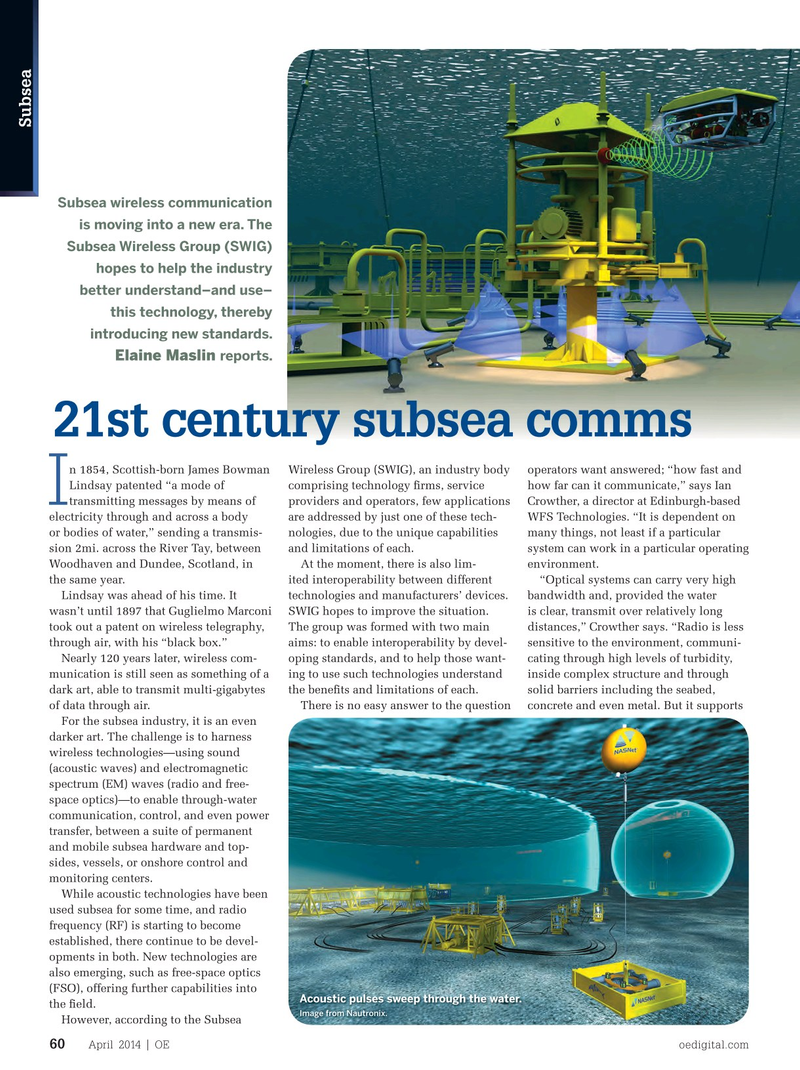
Page 58: of Offshore Engineer Magazine (Apr/May 2014)
Read this page in Pdf, Flash or Html5 edition of Apr/May 2014 Offshore Engineer Magazine
Subsea
Subsea wireless communication is moving into a new era. The
Subsea Wireless Group (SWIG) hopes to help the industry better understand–and use– this technology, thereby introducing new standards.
Elaine Maslin reports. 21st century subsea comms n 1854, Scottish-born James Bowman Wireless Group (SWIG), an industry body operators want answered; “how fast and
Lindsay patented “a mode of comprising technology ? rms, service how far can it communicate,” says Ian
I transmitting messages by means of providers and operators, few applications Crowther, a director at Edinburgh-based electricity through and across a body are addressed by just one of these tech- WFS Technologies. “It is dependent on or bodies of water,” sending a transmis- nologies, due to the unique capabilities many things, not least if a particular sion 2mi. across the River Tay, between and limitations of each. system can work in a particular operating
Woodhaven and Dundee, Scotland, in At the moment, there is also lim- environment.
the same year. ited interoperability between different “Optical systems can carry very high
Lindsay was ahead of his time. It technologies and manufacturers’ devices. bandwidth and, provided the water wasn’t until 1897 that Guglielmo Marconi SWIG hopes to improve the situation. is clear, transmit over relatively long took out a patent on wireless telegraphy, The group was formed with two main distances,” Crowther says. “Radio is less through air, with his “black box.” aims: to enable interoperability by devel- sensitive to the environment, communi-
Nearly 120 years later, wireless com- oping standards, and to help those want- cating through high levels of turbidity, munication is still seen as something of a ing to use such technologies understand inside complex structure and through dark art, able to transmit multi-gigabytes the bene? ts and limitations of each. solid barriers including the seabed, of data through air. There is no easy answer to the question concrete and even metal. But it supports
For the subsea industry, it is an even darker art. The challenge is to harness wireless technologies—using sound (acoustic waves) and electromagnetic spectrum (EM) waves (radio and free- space optics)—to enable through-water communication, control, and even power transfer, between a suite of permanent and mobile subsea hardware and top- sides, vessels, or onshore control and monitoring centers.
While acoustic technologies have been used subsea for some time, and radio frequency (RF) is starting to become established, there continue to be devel- opments in both. New technologies are also emerging, such as free-space optics (FSO), offering further capabilities into
Acoustic pulses sweep through the water. the ? eld.
Image from Nautronix.
However, according to the Subsea
April 2014 | OE oedigital.com 60 000_OE0414_Subsea1_wireless.indd 60 3/22/14 9:20 PM

 57
57

 59
59